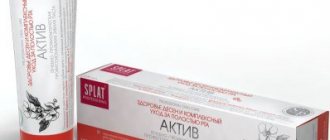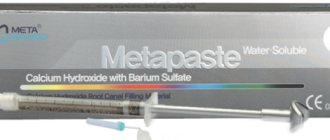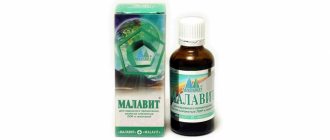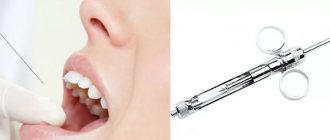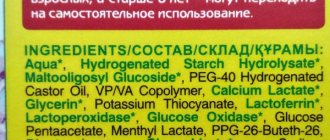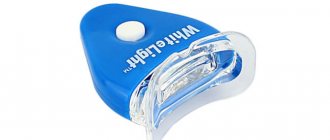4429
Pulpitis is diagnosed in a third of all patients who visit dentists. Most often, its treatment ends with pulpectomy - complete removal of the pulp and obturation of the canals.
The biological (vital) method of treatment (pulpotomy) is used much less frequently. Although, based on its merits, it deserves much more attention from dentists.
Composition and release form
The product is available in powder and liquid form, 30 g and 15 ml, respectively. The substances included in Pulpotec promote the effective treatment of temporary and permanent molars, aseptic healing of the internal soft tissues of the tooth with maximum preservation of its root structure.
The effect of the drug makes it possible to minimize the risk of complications characteristic of total pulpotomy.
The main active ingredients of the powder part of the drug:
- Zinc oxide (concentration up to 100%).
- Iodoform.
- Polyoxymethylene.
The liquid contains the following substances:
- Formaldehyde.
- Phenol.
- Dexamethasone acetate.
- Guaiacol.
- Auxiliary components.
WARNING:
Do not use Pulpotec during pulp extraction. Avoid contact of the material with soft tissues. In case of contact, rinse thoroughly with running water. Contains formaldehyde and polyoxymethylene. Toxic if inhaled and swallowed. May cause irritation, burning or hypersensitivity upon direct contact with skin. In case of contact with eyes, rinse with running water and consult a doctor.
Storage : Store at a temperature of 5-30 ◦C, avoid direct light.
Made in Switzerland
Packaging : in 2 bottles: 15 g of powder and 15 ml of liquid.
You can buy Pulpotec (Pulpotek) - a paste for long-term treatment by pulpotomy of living molars (15 g + 15 ml) produced by PD at ExDent.ru at a price of 5,700 rubles.
General concept of drug effects
Pulpotec is used for diseases of the pulp of both temporary and permanent molars. When using the medicine, the following happens:
- the pulp of the inflamed crown is removed;
- the bleeding stops (press cotton balls for a few minutes);
- the drug is introduced into the pulp chamber;
- the dental cavity is temporarily filled;
- after 8-10 days, temporary cement and remaining medication are removed;
- a denser ball of medication is introduced into the tooth cavity;
- install a permanent filling.
The effectiveness of the medicine is time-tested. After its use, pain disappears in 80-85% of cases.
Indications and contraindications for use
Pulpotek is used for:
- carrying out vital pulpotomy of permanent teeth in adult patients, including those cases when subsequent prosthetics are necessary (installation of a crown or bridge);
- pulpitis of vital non-permanent teeth in children;
- treatment of calcified root canals in elderly patients;
- restoration of molars whose roots have not yet fully formed;
- treatment of infected non-permanent molars by pulpectomy, including in the presence of inflammation (in this case, the medication is not administered into the canals of temporary teeth in children).
The drug has found wide application in pediatric dental practice.
The drug is not recommended for use in the following cases:
- the patient exhibits hypersensitivity to the components of the drug;
- the patient suffers from chronic diseases (diabetes, kidney inflammation, leukemia, etc.)
- with diffuse type pulpitis.
INDICATIONS:
- Adults: treatment of pulpitis of vital permanent teeth, including prior to prosthetics (single and bridge crowns);
- Elderly: treatment with pulpotomy of significantly calcified root canals
- Children: treatment of pulpitis of vital temporary molars. Treatment of pulpitis of underdeveloped but vital permanent molars, making it possible to carry out complete radicular restoration. Treatment of infected primary molars using pulpotomy, even in the presence of an abscess. This indication is the only exception to the rule of pulpotomy on living teeth, in which Pulpotek is not inserted beyond the bottom of the pulp cavity into the root canal of baby teeth.
Directions for use: Perform pulpotomy in the usual way. It is also recommended to use the material after pulpotomy performed with a laser.
Methods of use
Partial devitalization of the pulp with the help of Pulpotec is in many ways similar to the complete devitalization of teeth, carried out with arsenic and paraformaldehyde preparations:
- Local anesthesia is administered in a manner determined by the clinical situation.
- The carious cavity is prepared using a diamond drill of the required size and shape. It is advisable to immediately prepare the crown part of the tooth for subsequent restoration.
- The pulpous chamber is opened and processed. The inflamed portion of the pulp is removed using a high-speed bur and/or laser. Access to root canals is provided.
- Antiseptic treatment of the tooth cavity is carried out with chlorhexidine, sodium hypochloride, dimexide or other antiseptic.
It is advisable to repeat the treatment 2-3 times. If there is no bleeding (a small amount of blood is acceptable), the pulp chamber is dried with an air stream. - Pulpotec is introduced into the tooth cavity. This can be done in two ways – standard and alternative; their differences are described below.
- A temporary filling is applied. A break of about 7 hours is taken to allow the paste to harden.
At the next visit, the tooth is filled and restored with permanent material. It can be applied on top of Pulpotec or on a layer of temporary cement.
For children
Treatment of pulpitis of temporary and permanent molars. In the first case, the use of the drug allows you to stop the inflammatory process in the dental pulp, remove pain and wait for the natural replacement of milk teeth with permanent elements of the jaw row.
When treating permanent molars, it is possible to complete the formation of dental roots.
For adults
- Treatment of pulpitis of permanent molars.
- Preparation of lateral chewing teeth for the installation of bridges and crowns.
- Treatment of teeth with obliterated, difficult to pass canals.
Contraindications:
- Hypersensitivity to the components of the product.
- Serious systemic diseases (leukemia, renal failure, diabetes, etc.).
- Diffuse pulpitis (spread of inflammation to the entire pulp, not only the coronal, but also the root).
- Resorption of more than half of the tooth root.
Standard
With the classic method, the doctor mixes the powdered component of the drug with liquid until a homogeneous paste without inclusions is obtained, and places a small ball of the drug inside the chamber.
If a small amount of blood is released during the process, it does not affect the effectiveness of the effect. The oral cavity itself is first dried, and after applying the material, a temporary filling is placed on the tooth.
To ensure that the drug adheres securely to the mouth of the canal and its walls, the doctor places a cotton wool roll between the patient’s teeth. When he bites it, the paste comes into close contact with the walls of the cavity, as a result of which the most effective treatment is ensured.
Alternative
The dentist may also apply the composition in another way. The product is mixed to a homogeneous consistency on a laboratory glass slide, then a ball is formed from the resulting medium-hard paste and placed in a chamber.
Then the product is pressed mechanically to ensure contact with all surfaces of the internal cavity, and a temporary filling is placed.
Polymerization requires about 7 hours; during the second visit to the doctor, the specialist uses dental cement to install a permanent filling. It can be performed directly on the drug bead.
Some specialists leave a small layer of temporary cement to isolate the main filling from Pulpotek.
Note:
Teeth treated with Pulpotec and covered with non-removable orthopedic structures (crowns or bridges) may show pain after several months (from 3 to 1 year), despite the absence of radiological signs of damage. They usually disappear after correction of the bite height.
To successfully perform a pulpotomy procedure with Pulpotec:
- Pulpotomy is a simple operation, but it must be performed flawlessly: the cutting must be done clearly and quickly to avoid rupture of the root pulp endings and isolation of the entire intracavitary pulp.
- the treatment applies only to vital molars (study all the indications in the annotation and be guided only by them).
- The seal isolating Pulpotec must be made absolutely hermetically to avoid leakage of the drug.
Warning:
Do not use Pulpotec during pulp extraction. Avoid contact of the material with soft tissues. In case of contact, rinse thoroughly with running water. Contains formaldehyde and polyoxymethylene. Toxic if inhaled and swallowed. May cause irritation, burning or hypersensitivity upon direct contact with skin. In case of contact with eyes, rinse with running water and consult a doctor.
Storage : Store at a temperature of 5-30 ◦C, avoid direct light.
Made in Switzerland.
Packaging : in 2 bottles: 15 g of powder and 15 ml of liquid.
Price: $65.
Analogues: Formocresol, Pulpodent.
2 METHODS OF APPLICATION OF PULPOTEK ARE RECOMMENDED:
1). Traditional method: Mix Pulpotec liquid with Pulpotec powder to form a smooth, creamy paste. Add the paste to the pulp chamber using a paste filler. The presence of a small amount of blood will not affect the effectiveness of the material. Dry the cavity immediately before adding the paste. Close the cavity with temporary cement, for example: Temporary cement in paste “PD”. In order to ensure a good fit of the paste to the walls of the canal and the mouth, place a cotton roller between the upper and lower molars, ask the patient to bite the roller, first lightly, then hard, so that the paste closely adapts to the walls of the pulp chamber and the mouth of the root canal.
2). Another method of application : mix the powder and liquid on a glass slide to the size of a small putty ball and place directly into the pulp chamber. Press with a tool and finish as described above with temporary cement and a cotton roll. The polymerization time of Pulpotec is about 7 hours.
At the second visit, the treatment is completed with the placement of a permanent restoration, which can be installed directly on Pulpotec. You can leave a thin intermediate layer of temporary cement to isolate Pulpotek from the filling material.
Possible side effects: In most cases, treatment with Pulpotec is painless. However, there may be cases of pain before a return visit in the following situations:
- Moderate pain lasts until the second visit. To stop it, you should remove the entire primary portion of the material, add a fresh portion and perform a temporary filling.
- Recurrent arthritic pain. Treated with anti-inflammatory treatment.
- In approximately 1 case in 1000, acute pain occurs as a result of: - treatment of an initially non-viable tooth; — undiagnosed fracture of the tooth crown or perforation of the cavity wall.
In this case, after removing the temporary cement, an accurate diagnosis should be established and appropriate treatment should be carried out either by pulpectomy or tooth extraction if necessary.
NOTE:
Teeth treated with Pulpotec and covered with non-removable orthopedic structures (crowns or bridges) may show pain after several months (from 3 to 1 year), despite the absence of radiological signs of damage. They usually disappear after correction of the bite height.
To successfully perform a pulpotomy procedure with Pulpotec:
- Pulpotomy is a simple operation, but it must be performed flawlessly: the cutting must be done clearly and quickly to avoid rupture of the root pulp endings and isolation of the entire intracavitary pulp.
- the treatment applies only to vital molars (study all the indications in the annotation and be guided only by them).
- the seal isolating Pulpotec must be made absolutely hermetically to avoid leakage of the drug
STORAGE CONDITIONS
Store in a dry place, protected from direct sunlight, in a tightly closed container, at a temperature from +5°C to +25°C.
Shelf life – 3 years.
Failure to comply with storage conditions leads to changes in the performance characteristics of the material and a reduction in its shelf life.
The manufacturer is not responsible for loss of product quality caused by non-compliance with the conditions of transportation, storage and use established by the manufacturer for these products.
Responsibility for using the material for purposes other than those specified by the manufacturer rests with the user.
Side effects
The medicine is well tolerated by patients. Often the drug does not cause pain, however, in some cases the following undesirable reactions may occur:
- mild pain, which, as a rule, goes away after a subsequent visit to the dentist (pain relief is carried out by introducing a new portion of material after removing the primary and installing a temporary filling);
- periodic arthritic pain that goes away after the inflammation is relieved with medications;
- acute pain is extremely rare (1:1000), the cause of sharp pain may be the treatment of a non-viable molar, or failure to detect a perforation of the cavity wall or a fracture of the dental crown (in this situation, temporary material is removed, a diagnosis is made and treatment is performed with a pulpectomy or the tooth is removed) .
Precautionary measures
The drug cannot be used when performing pulp extraction. After mixing, the material should not come into contact with soft tissues and mucous surfaces of the oral cavity. If it gets on the inside of your cheeks or tongue, rinse your mouth with clean water.
The product contains formaldehyde, therefore, mild or moderate poisoning
If the product comes into contact with the skin, it causes redness, itching, burning and sensitivity, so in this case you need to wash off the drug.
If the product gets into your eyes, rinse with plain water and immediately contact a specialist.
In order for the procedure to be carried out as efficiently and painlessly as possible, you must also take into account the following recommendations:
- Cutting off the affected part of the pulp is carried out quickly and carefully so that the ends of the root segment do not rupture and the intracavity area does not become isolated.
- Treatment using the drug is allowed only for vital molars.
- When filling, whether it is a temporary or permanent procedure, it is necessary to ensure that the cement ensures maximum tightness of the cavity.
If cracks or gaps remain, saliva, food, and liquid will get inside. This leads to disruption of the condition of the pulp, can provoke re-infection and increase the risk of toxic effects of the drug on the body.
Reviews
The results of vital extirpation largely depend on the qualifications of the doctor. It is necessary to be able to accurately determine the area of spread of the inflamed pulp in order to minimally affect the healthy part.
If you or your child have undergone partial devitalization of teeth, share your impressions about it with our specialists and patients, leave your comment at the bottom of this page.
If you find an error, please select a piece of text and press Ctrl+Enter.
Tags medications pulpitis
Did you like the article? stay tuned
Previous article
Basics of tooth restoration with Glassix fiberglass pin
Next article
In what cases is a disconnecting mouthguard used and the mechanism of action of the device?
Analogues and prices
The cost of one of the components of the drug varies from 1,700 to 2,500 rubles, depending on the city and the specific pharmacy.
The price of a set consisting of a portion of powder and a bottle of liquid is 4-4.5 thousand.
The drug has several analogues of both Russian and foreign origin:
- Pulpodent. This Russian drug, available in the form of a powder with liquid, provides an analgesic effect, relieves inflammation and mummifies the pulp.
The shelf life, like the product in question, is 3 years, the cost varies between 700-1000 rubles. - Formocresol. This is a foreign analogue that contains cresol in a consistency of 35% and formaldehyde 19%; when exposed to it, it leads to mummification of the pulp in the molar root (in whole or in part depending on the duration of treatment).
The product costs 190-250 rubles, but it is difficult to find for sale in Russian pharmacies. - Instillagel. The composition includes lidocaine hydrochloride, chlorhexidine gluconate, water, propylene glycol and a number of excipients.
The product provides disinfecting, anti-inflammatory and mummifying effects, shelf life - 5 years. A 6 ml syringe costs about 1100-1500 rubles.
Price and analogues
The price of Pulpotek in Russian stores varies slightly - between 4200-4300 rubles.
The most famous imported analogue of Pulpotec is the Japanese drug Palpack V (Palpak) , containing methylphenol formaldehyde, eugenol, zinc oxide and some other components.
The kit includes materials that allow you to install 250-300 gaskets. The approximate price of Palpak is 3500-3700 rubles.
The Russian manufacturer VladMiV produces two drugs used for vital pulpotomy.
- Pulpodent (25 g of powder and 12 mm of liquid) costs 500-700 rubles.
- Formocresol (pulpevit No. 3) , offered in online stores for 200-220 rubles.
Pulpodent - instructions
Treatment of pulpitis using the vital amputation method is carried out in two visits.
On the first visit, after anesthesia and preparation of the carious cavity with a sterile bur, open the pulp chamber and amputate the coronal pulp with a sharp spherical bur.
Then carefully perform hemostasis to avoid the formation of a clot, which can prevent contact of the paste with the pulp stump and, if infected, lead to complications. After the bleeding has completely stopped, the cavity must be dried with a sterile cotton swab and the pulp stump covered with a paste obtained by mixing the powder with liquid.
To do this, on a glass plate at a temperature of 22±1°C and a humidity of 55±10%, mix 1 measuring cup (0.10-0.12 g) of powder with 2 drops of liquid (0.05-0.06 g) until a homogeneous mass is obtained. .
The paste placed on the pulp stump is covered with a temporary eugenol-free material (“Dentin powder”), which is carefully compacted to create a seal in the stump area. The amount of paste should be optimal to prevent leakage onto the gums when compacting the paste. To ensure good adhesion of the paste to the walls and mouth of the canal between the upper and lower molars, you can place a cotton roll and ask the patient to bite on the roll without much effort.
On the second visit after 8-10 days, if there is no pain and after an X-ray of the tooth confirms the success of the treatment, it is recommended to remove the temporary filling and material and add a fresh portion of Pulpodent paste of a denser consistency to the tooth cavity. Then the preparation should be isolated with eugenol-free material, the tooth crown should be restored with a composite or compomer or using glass ionomer cement.
Material stored or transported at low temperatures must be kept at room temperature for at least 1 hour before use.
Features of the composition and medicinal properties
Pulpodent is available in two forms: powder and liquid, their components differ:
- Powder . It is based on polyoxymethylene as an antiseptic. The substance is capable of providing pulp devitalization, but in a partial volume. The powder also contains iodoform, which is responsible for a long-term antibacterial effect, and several other additional substances.
- Liquid . The antiseptic contained in the drug in liquid form is eugenol. Another beneficial property of this substance is its calming effect. Another element with antiseptic properties is phenol, which is responsible for maintaining the residual pulp sterile. Dexamethasone, used at a concentration of 0.13%, is a glucocorticosteroid that has an antiallergic effect and accelerates the process of relieving inflammation.
The active substances provide the drug with the following medicinal properties:
- analgesic;
- anti-inflammatory;
- mummifying.
As for the mummifying property, only a small part of the pulp is exposed to it, which is in direct contact with the drug. The apical part remains complete and viable. Pulp tightness also remains unchanged.
Application area
Pulpodent is used in the treatment of various types of pulpitis: both chronic and acute. Chronic pulpitis can occur in several forms:
- Focal . This form of the disease is characterized by severe, acute pain, often paroxysmal.
- Diffuse . This form of the disease is permanent, pain may not stop at all, only occasionally becoming less noticeable.
Acute pulpitis also has several forms:
- Fibrous . It is characterized by aching pain, which increases with rising temperature, changing weather conditions and in the event of exposure to other external irritants.
- Hypertrophic . With this form of the disease, pain appears only if the affected area is irritated.
- Gangrenous . The pain can be constant or periodically aching. A characteristic feature of this course of the disease is bad breath.
The use of the drug is effective for any course of the disorder.
Instructions for use
Before using the Pulpodent material, it must be kept at room temperature for at least 1 hour.
When using the vital amputation method, treatment using this material takes place in several stages:
- Application anesthesia is performed . Most often, a syringe with a needle of the required shape is used for this, depending on the location of the tooth.
- Then the coronal pulp is removed . After the bleeding has completely stopped, the pulp stump is covered with a mixture prepared from powder and liquid. The treated area is then covered with temporary material.
- After about a week, an x-ray is taken and if the result is positive, then the temporary material is removed and a portion of a new mixture is applied in its place.
- Then the crown of the tooth is restored .
To prepare the mixture, powder and liquid are used in a 1:2 ratio.
Doctors say
From reviews of doctors who use Pulpotek in their medical practice.
I have been using the drug in my practice for three years now. Fortunately, there are no complaints from patients. One drawback is that only viable pulp can be treated, which bleeds when opened.
Nina Olegovna, pediatric dentist
For several years I have been performing pulpotomy on vital molars using Pulpotec. Under anesthesia, I amputate the crown pulp, perform hemostasis and inject a paste made from this material.
After this, I apply a glass ionomer gasket and restore the tooth crown. The drug has fully justified itself under these conditions.
Elizaveta Nikolaevna, pediatric dentist

